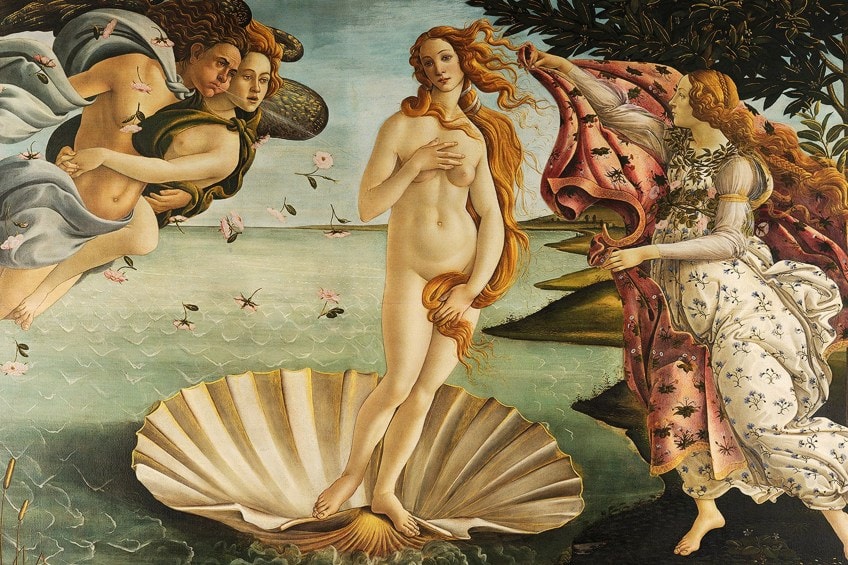“The Birth of Venus” Botticelli – Learning About This Iconic Painting
Sandro Botticelli, one of the original prodigies of the Italian Renaissance era, is renowned for his artistic contribution to the significant art movement. While his work includes secular portraiture and Scriptural portrayals, he is most recognized for his larger-than-life mythical settings, such as The Birth of Venus painting. Sandro Botticelli’s treatment of subject matter distinguishes The Birth of Venus painting from previous Renaissance portrayals, in addition to aesthetic features such as brushwork and color. In this article, we will not only answer the basic questions such as “When was The Birth of Venus painted?” and “Where is The Birth of Venus now?”, but we will also be taking an in-depth Birth of Venus analysis.
The Birth of Venus by Botticelli
Before delving into the topic, it is critical to evaluate the medium. This is a tempera painting on canvas. Wooden paneling was a popular surface for painting at the period, and they would stay so until the end of the 16th century. Artists, on the other hand, were beginning to adopt canvas. It functioned effectively in humid areas like Venice since wooden panels tended to bend in such conditions. Canvas was likewise less expensive than wood, but it was also regarded as less formal, making it more suited for paintings displayed in non-official settings such as countryside homes instead of urban mansions. But who is Sandro Botticelli, the man who painted The Birth of Venus?
Who Was Sandro Botticelli?
| Nationality | Italian |
| Date of Birth | c. 1445 |
| Date of Death | 17 May 1510 |
| Place of Birth | Florence, Italy |
Who is the artist of the Birth of Venus? Sandro Botticelli’s paintings were thought to be among the best of the Renaissance not long after his death, notably by artists like the Pre-Raphaelites. Botticelli’s career was characterized by accomplishment, the pinnacle of which saw him create some of the murals in the Sistine Chapel.
Botticelli is most known for his artworks La Primavera (1477 – 1482), The Birth of Venus (1485 – 1486), and Venus and Mars (1483).
Despite his reputation and renown, Botticelli’s professional career is marred by its end, which was weakened by the new creative ideology of the High Renaissance. Botticelli’s vocation began when he was 14 years old when he was assigned to Fra Filippo Lippi, who had a significant influence on his style of painting, and many academics are quick to remark that he acquired Lippi’s intimate and meticulous creative method. Botticelli’s developing renown as an artist was due to the sensitive emotions on the faces of his figures, as well as his ornamental technique.

Botticelli’s developing talent enabled him to create his own studio aged 15. Such skill growth resulted in a distinct creative style, which was exemplified by life-like figures painted in a sad or melancholy way. His inclusion of Neo-Platonism was probably one of the most remarkable parts of his oeuvre, which undoubtedly contributed to his success at the time. By integrating Catholicism and paganism in his compositions, he was able to appeal to a wide range of preferences.
Botticelli’s profession was defined by the relationships, finances, and greater renown that arose as a result of the Medici family’s donation. The Medicis were a renowned and affluent family in Florence, and as Botticelli’s popularity grew, the family enlisted him to paint portraits of its important members.
Botticelli’s renown skyrocketed as a consequence of the Medici power, and he was summoned to Rome by the Papacy to fresco parts of the Sistine Chapel. A few of the Renaissance’s finest painters shared such an accolade. The Papacy was the most acknowledged expert in that field during Botticelli’s time.

A papal blessing was the greatest validation for any budding painter, and the chance to decorate one of Rome’s most important masterpieces, The Sistine Chapel, was the pinnacle of accolades. Botticelli’s later career was shaped by the eccentric friar Savonarola, who lived in Florence. At the height of his fame, Savonarola burnt countless pieces of art and publications that he considered unholy.
Some of Botticelli’s paintings were included among such pieces, but even after Savonarola’s widespread collapse and inevitable death, Botticelli’s works remained highly religious. Despite the temptation to depart after Savonarola’s demise, Botticelli stayed in Florence and established himself as one of the finest altarpiece painters. Notwithstanding his achievements, Botticelli’s later career was marred by a period of enormous upheaval in Florence, which would lead to difficult times for the artist.
Botticelli took tough assignments that other painters would not take in order to stay up with continually changing approaches and methods. Botticelli’s downfall was accelerated by the arrival of the High Renaissance, which rendered his artistic style obsolete in contrast.
The Birth of Venus Analysis
| Date Completed | 1485 – 1486 |
| Medium | Tempera on Canvas |
| Dimensions | 172 cm x 278 cm |
| Current Location | Uffizi, Florence |
The Birth of Venus by Botticelli is recognized as one of the most renowned artworks around the globe and an emblem of the Italian Renaissance period. It was practically unparalleled in Western art since antiquity to portray a topic from ancient mythology on such a vast scale, as was the magnitude and presence of a naked female figure in the painting.
Most art historians believe that deciphering the significance of the Birth does not need a complicated examination.
While the picture has complexities, its basic meaning is a clear, if distinctive, presentation of a familiar scenario from Greek mythology, and its attraction is sensory and highly approachable, which explains its huge popularity.
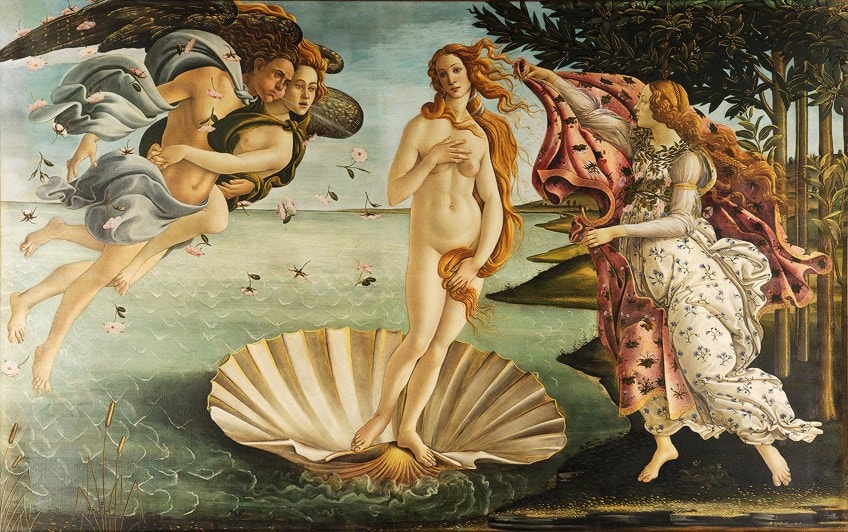
Subject and Description
Venus, the newly-born deity, appears naked in a large seashell in the center. The scale of the shell is entirely fictitious, and it may also be seen in classical portrayals of the topic. The wind deity Zephyr blasts at her from the side, with the wind depicted by lines emanating from his lips. He’s in the air, accompanied by a young woman who’s also puffing, but less vigorously. They both have wings. Vasari was most likely accurate in characterizing her as “Aura,” the goddess of a gentle wind.
Their combined attempts are pushing Venus towards the coast and wafting the other figures’ tresses and garments to the right. A feminine figure on the right, who might be hovering somewhat above the earth, holds out a costly cloak or clothing to conceal Venus when she arrives at the coast.
She is one of the three Greek minor deities of the seasons and various partitions of time who serve as Venus’s companions. Her floral-decorated gown indicates that she is the Hora of Spring.

Possible identities for the two secondary feminine characters include those featured in the Primavera; the sprite held by Zephyr might be Chloris, a flower sprite he wedded in certain interpretations of her narrative, and the one on land could possibly be Flora.
Flora is the Roman counterpart of the Hellenic Chloris, who is turned into the form of Flora beside her, after Ovid’s Fasti, although such a transition is difficult to observe here.
The flowers blowing along with the two winged figures, on the other hand, would be fitting for Chloris. The topic is not technically the “Birth of Venus,” a term given to the picture only in the 18th century, but the next moment in her narrative, in which she comes on land, driven by the wind. The area is most likely Cyprus or Cythera, two Mediterranean islands considered by the Greeks to be Venus’s realms.
Technical Birth of Venus Analysis
The Birth of Venus by Botticelli is rather large and was produced on canvas. Canvas was becoming more popular, maybe notably for secular artworks for country homes, which were painted more simply, inexpensively, and joyfully than those for urban palazzi, and were intended for enjoyment rather than pompous entertainment.
The artwork is on two portions of canvas that were sewed together before beginning, with a blue-tinted gesso base.
There are some contrasts between this and Botticelli’s customary approach of painting on panel supports, such as the absence of a green initial layer under the fleshy parts. Current scientific testing has uncovered a lot of pentimenti. The Hora was initially wearing “low classical sandals,” and the ruff on the mantel she is holding is an afterthought.
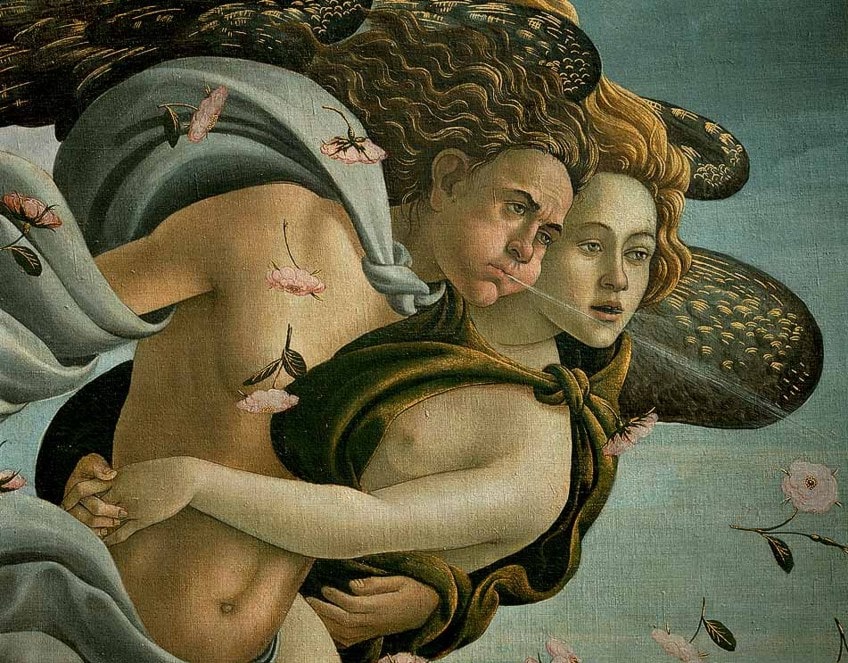
Venus’s and the flying couple’s hairstyles were altered. Gold is frequently used as an accent color in tresses, wings, fabrics, the shell, and the scenery. All of this appears to have been done after the picture had been framed. It was polished with a “cold gray varnish,” most likely made from egg yolk.
The green pigment – utilized for Zephyr’s wings, and the foliage of the trees on the land – has discolored significantly with light exposure over time, somewhat disrupting the desired color balance. Some leaves in the upper right corner, which are generally hidden by the framework, have been less impacted. The blue of the water and sky have likewise faded in intensity.
Style of the Birth of Venus Painting
Although Venus’s attitude is traditional in certain ways, borrowing the placement of the hands from the Greco-Roman statues, the general presentation of the body, standing off-center with a curving frame of long and wavy lines, is influenced by Gothic art. Her departures from classical design are not biological, but structural and rhythmic.
It lacks the attribute of aplomb, which is highly valued in classical art; that is, the body’s mass is not divided evenly on each side of a center plumb line.
She is floating rather than standing. Her shoulders, for instance, flow down into her limbs in the same uninterrupted line of motion as her flowing hair, rather than producing a sort of architrave to her body as in the ancient nude. Venus’ anatomy is physically unusual, with an extended throat and torso.
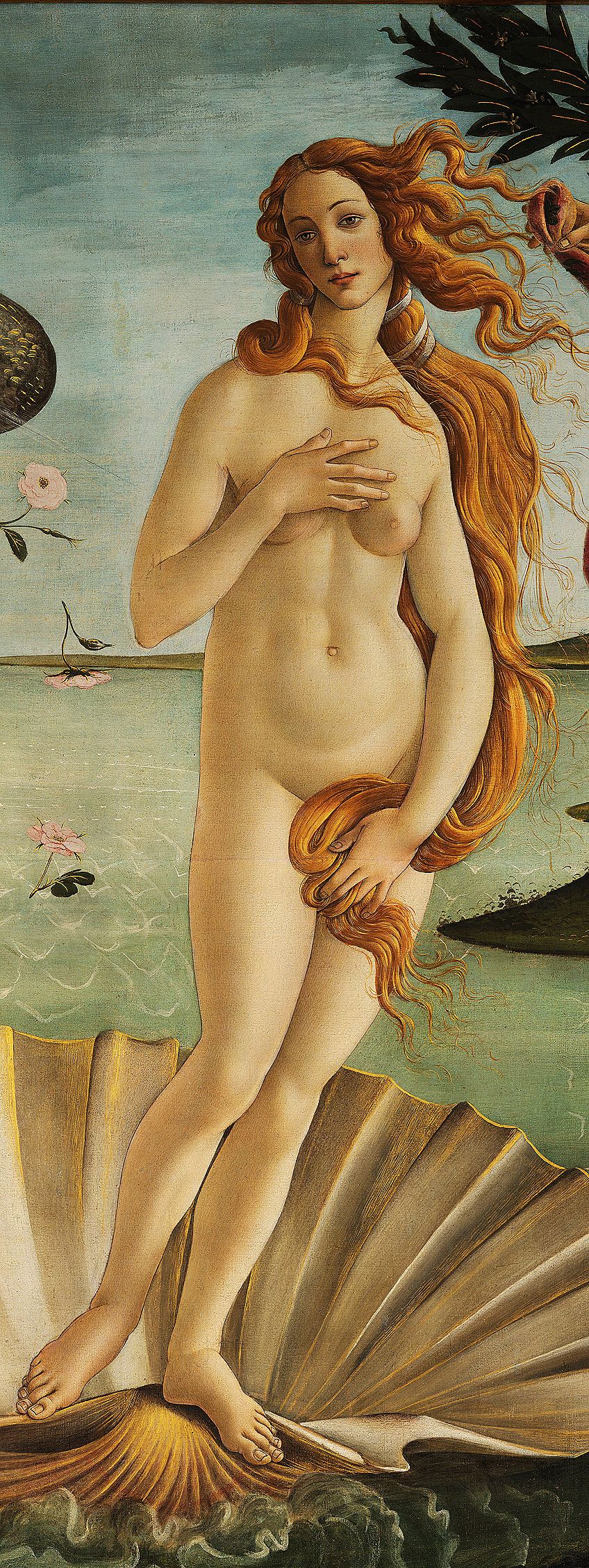
Her position is hard to hold because, although standing in a classic contrapposto posture, her body weight is moved too much over her left leg for the stance to be held. The dimensions and positions of the breezes to the left are off, and none of the characters throw shadows. Rather than being preoccupied with the accurate portrayal, the artwork represents the world of the imagination.
Kenneth Clark refers to the flying couple on the left, disregarding the size and location of their wings and limbs as, “perhaps the most magnificent instance of euphoric motion in the entire history of painting.”
The delicate rhythms of the draperies, which sweep and flow seductively around the naked figures, achieve the inhibition of our reasoning.

Their bodies maintain the stream of motion, which eventually pulsates down their legs and disperses like an electric charge, via an unending complexity of embrace. Botticelli’s painting was never totally dedicated to naturalism; unlike his colleague Domenico Ghirlandaio, he seldom provided weight and dimension to his characters and seldom employed a deep perspectival area.
Botticelli was seldom known for painting landscape backdrops with tremendous detail or accuracy, but this is particularly true here.
The laurel bushes and grass underneath them are greenish with gold accents, the majority of the waves have repeating patterns, and the environment appears out of proportion to the humans. The clusters of bulrushes in the immediate foreground belong to a freshwater variety and are thus out of context here.
History and Dating
Why and where was the Birth of Venus painted? It has long been assumed that the painting was funded by the Medici family, possibly by Lorenzo di Pierfrancesco de’ Medici, a key supporter of Botticelli, under the sway of his relative Lorenzo de’ Medici. This was initially proposed by Herbert Horne in his book on Botticelli in 1908, the very first significant contemporary book on the artist, and was long recognized by most authors, but has since been widely questioned, though it is still acknowledged by some.
Several theories of the painting’s significance hinge on its origins.
While ties between Lorenzo and his young cousins, were possibly always strained, it may have been strategic to acquire a work that praised the older Lorenzo, as some explanations have it. There may be an intentional doubt as to which Lorenzo was meant to be invoked. Later in life, antagonism between the two divisions of the family became obvious.

Horne felt that the picture was ordered soon after Lorenzo purchased the Villa di Castello, a rural residence outside Florence, in 1477, to adorn their new residence, which they were renovating. It was the year following their father’s death, leaving the young brothers as dependents of their cousin Lorenzo Il Magnifico. There is no documentation of the initial request, and the picture is referenced for the first time by Vasari, who had seen it at Castello some point before the first publication of his Lives in 1550.
Vasari was working in the mansion around 1550, but he may have visited it earlier. However, the Birth was not included in the seemingly full inventory of artworks belonging to Lorenzo di Pier Francesco’s side of the family made in 1499. Ronald Lightbown thinks that it was only after then that it came to be possessed by the Medici. The inventory was only released in 1975, yet it invalidated many earlier beliefs.
Horne dates the work between the acquisition of the estate in 1477 and Botticelli’s journey to Rome in 1481 to start the Sistine Chapel painting. Recent experts favor a date of between 1484 and 1486 because of the work’s significance in the evolution of Botticelli’s technique.
Interpretations
Although there are related ancient and current writings, no single text offers the precise picture of the artwork, prompting researchers to propose a variety of origins and explanations. Many scholars who focus on the Italian Renaissance believe that Neoplatonic explanations, of which two variations have been expressed by Ernst Gombrich and Edgar Wind, are crucial to grasp the artwork.
Botticelli depicted the Neoplatonic concept of divine love as a naked Venus.
Venus seemed to have two facets for Plato – and thus for the Florentine Platonic Academy: she was a corporeal deity who stimulated humans to physical affection, or she was a celestial divinity who influenced scholarly love in them. Plato went on to assert that contemplating physical beauty helped the brain comprehend spiritual elegance.

Viewing Venus, the most attractive of deities may elicit a bodily reaction in observers, which then directs their attention to the holy. A Neoplatonic interpretation of the Birth of Venus by Botticelli implies that 15th-century spectators would have felt their imaginations raised to the world of heavenly love when they looked at the picture.
The arrangement, with a center naked body and one to the side with an arm, lifted over the first’s head, and flying figures in presence, would have reminded Renaissance audiences of the customary imagery of Christ’s Baptism, signifying the beginning of his service on earth. Similarly, the scenario depicted here symbolizes the beginning of Venus’s service of love, whether in a literal sense or in the broader context of Renaissance Neoplatonism.
Scholars have lately raised concerns regarding Neoplatonism as the prevailing philosophical framework in late 15th-century Florence, and they have suggested that there may be other ways to understand Botticelli’s mythical paintings. Both the Birth of Venus painting and Primavera, in particular, have been seen as bridal artworks that promote suitable behavior for engaged couples.
The laurel branches at right and the laurel crown donned by the Hora are clever allusions to the moniker “Lorenzo,” however it is unclear if Lorenzo il Magnifico, Florence’s actual ruler, or his younger relative Lorenzo di Pierfrancesco is intended. Similarly, the blossoms in the air surrounding Zephyr and on the fabrics donned and transported by the Hora conjure up the word Florence.
Further Interpretations
Charles R. Mack, an art expert, and scholar, offers another view on the Birth of Venus. He goes on to describe the picture as a metaphor glorifying the qualities of Lorenzo de’ Medici, which incorporates much of what is commonly agreed upon. This has not been accepted by Renaissance art scholars generally, and it remains controversial, because it is based on the picture being requested by the Medici, yet the piece is not verified in Medici possession until far into the next century.
The scenario, according to Mack, was motivated by both the Homeric Hymn and the older artworks. But much more than a resurrected Homeric song was most likely on the thoughts of the Medici member of the family who requested Botticelli’s artwork. Botticelli’s depiction of the Birth of Venus may be considered as fulfilling, if not surpassing, the effort began by his ancient precursor Apelles. While Botticelli was regarded as a resurrected Apelles, his Birth of Venus also spoke to the unique personality of Florence’s leading citizen, Lorenzo de’ Medici.
Even though it currently appears that the artwork was done for another relative of the Medici family, it was most likely done to honor and flatter the family’s head, Lorenzo de’ Medici.
The impression of Venus in Botticelli’s artwork is traditionally associated with the renowned beauty Simonetta Cattaneo Vespucci, of whom prevalent lore asserts both Lorenzo and his younger brother, Giuliano, were enthusiastic supporters. Thereby, in Botticelli’s perception, Pankaspe, Alexander the Great’s consort, has become the delightful prototype for the misplaced Venus painted by the ancient Greece artist Apelles, which wound up in Rome, fitted by Emperor Augustus in the sanctuary devoted to Florence’s presumed founding member Julius Caesar.

In the instance of the Birth of Venus by Botticelli, the inferred allusions to Lorenzo, supplemented by other intrinsic signs such as the row of laurel plants on the right, would have been exactly what sophisticated Florentine humanists would have admired. As a result, Lorenzo has become the new Alexander the Great, with an inferred relationship to both Augustus, the very first Emperor of Rome, and even Florence’s fabled progenitor, Caesar himself.
Moreover, Lorenzo is not only handsome but also benevolent, like Alexander was in Pliny’s account. Finally, these observations of the Birth of Venus suit not only the Medicis but the entire city of Florence, which is residence to befitting proteges to some of antiquity’s finest figures in the arts.
These primarily pagan assessments of the Birth of Venus painting should not be mistaken for a more solely religious one, which may be deduced from the artwork’s Neoplatonic viewing.
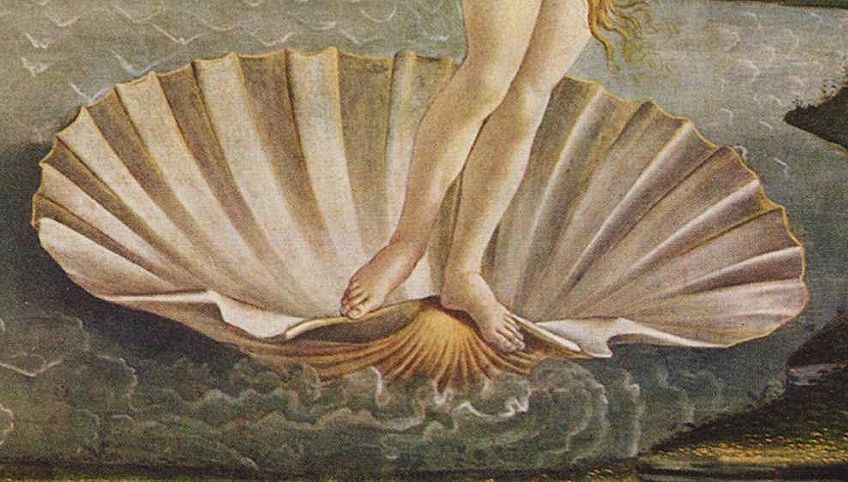
Viewed from a theological angle, the nakedness of Venus evokes that of Eve just before Descent as well as the universal love of Heaven. Once there, the deity of love will take on the earthly guise of deadly sin, ushering in the New Eve – whose cleanliness is portrayed by the naked Venus. She has become a representation of the Church after she is dressed in earthly robes, offering a spiritual transit back to the adoration of everlasting redemption.
The shell on which this figure of Venus stands can be seen in its customarily significant pilgrimage setting in this instance.
Moreover, the vastness of the sea acts as a reference of the Virgin Mary’s title, referring to both Madonna’s name and the celestial body Venus. The sea gave life to Venus, just as the Virgin gave life to Christ, the greatest emblem of love. Instead of selecting one of the various interpretations presented for Botticelli’s Birth of Venus painting, consider seeing it from a number of angles. This multifaceted methodology (mythological, ideological, and spiritual) was anticipated.
Influence from Ancient Art
Creating a significant standing woman’s naked body as the primary theme was unparalleled in post-classical Western art, and undoubtedly drew on the traditional sculptures that were coming to light at the time, particularly in Rome, where Botticelli had worked on the wall surfaces of the Sistine Chapel.
The posture of Botticelli’s Venus is based on the “Venus of Modesty” archetype from ancient Greece, in which the hands are held to hide the bosom and crotch.
The Venus de’ Medici, a stone statue in Medici possession in Rome by 1559, had become a prominent specimen of this kind, which Botticelli may have had the chance to evaluate. The artist and the humanist professors who most likely counseled him would have remembered Pliny the Elder mentioning a lost masterwork of the great ancient Greek artist Apelles, depicting Venus Anadyomene.

Thus, according to Pliny, Alexander the Great volunteered his lover, Campaspe, as the subject for the naked Venus and then, recognizing Apelles had grown to love with her, handed her to the craftsman in a show of extraordinary graciousness. Pliny went on to say that Apelles’ picture of Pankaspe as Venus was “devoted by Augustus at his father Caesar’s temple.”
Pliny also claimed, “The bottom section of the artwork had been ruined, and it was hard to locate somebody who could repair it. This artwork deteriorated due to age and rust, and Nero replaced it with another artwork by Dorotheus.” Pliny also mentioned a second picture of Venus by Apelles that was “better even to his former one” that had been started but left incomplete by the artist.
The Roman depictions in different media depicting the newborn Venus in a massive shell might be rudimentary derivatives of these paintings. Botticelli may not have viewed the later Pompeii frescoes, but he could have seen miniature reproductions of the theme in clay or etched jewels.
The “House of Venus” at Pompeii contains a life-size mural of Venus reclining in the shell, which is also seen in other paintings; in most other pictures, she poses with her hands on her head, squeezing the water out of it.
Other Versions
In another painting from around 1490, Botticelli, or most likely his studio, replicated the image of Venus. This life-sized piece features a similar person and stance, partially dressed in a light shirt and set against a simple dark background. It is located in Turin’s Galleria Sabauda. Venus has another factory in Berlin, and it’s likely that more were burned in the “Bonfire of the Vanities.”
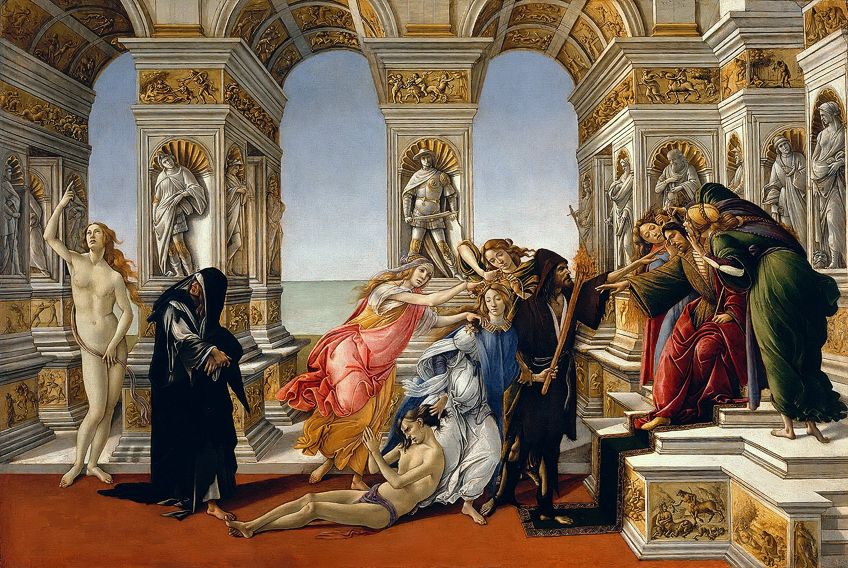
Examples appear to have been transferred to France and Germany, where they most likely influenced Lucas Cranach the Elder and many others. More than 10 years later, in his Calumny of Apelles, Botticelli altered the form of Venus for a naked embodiment of “Truth.” One hand is lifted, gesturing to the sky for vindication, and the figure’s attention is likewise skyward; the whole impact is much different.
Sandro Botticelli, a prodigy of the Italian Renaissance era, is well-known for his creative contribution to the important art movement. While his art contains secular portraits and Scriptural depictions, he is most known for his larger-than-life legendary settings, such as the masterpiece The Birth of Venus. In addition to aesthetic aspects like brushwork and color, Sandro Botticelli’s approach of subject matter separates The Birth of Venus painting from prior Renaissance depictions.
Take a look at our The Birth of Venus painting webstory here!
Frequently Asked Questions
Who is the Artist of The Birth of Venus?
If you want to know who painted the Birth of Venus, then look no further! The artist is famed Italian painter Sandro Botticelli. Not long after his death, painters such as the Pre-Raphaelites considered Sandro Botticelli’s paintings to be among the greatest of the Renaissance. Botticelli’s career was marked by achievement, with the climax being the creation of some of the wall paintings in the Sistine Chapel. Despite his notoriety and acclaim, Botticelli’s professional career is damaged by its conclusion, which was undermined by the High Renaissance’s new creative ideology. Botticelli’s career began when he was just 14 years old.
When Was The Birth of Venus Painted?
The painting is said to have been ordered shortly after Lorenzo acquired the Villa di Castello, a country property outside Florence, in 1477, to adorn their new home, which they were remodeling. There is no documentation of the initial request, and the image is mentioned for the first time by Vasari, who saw it at Castello before the first publication of his Lives in 1550. The Birth, on the other hand, was not included in the supposedly complete inventory of artworks completed in 1499 by Lorenzo di Pierfrancesco’s side of the family. Ronald Lightbown believes that it was only after then that it came under the control of the Medici. Some historians believe that it was only after then that it got into the hands of the Medici. Even though the inventory was first disclosed in 1975, it disproved several previously held ideas. Horne places the work between the purchase of the land in 1477 and Botticelli’s trip to Rome in 1481 to begin work on the Sistine Chapel painting. Because of the work’s significance in the growth of Botticelli’s technique, recent scholars propose a date of 1484–86.
Where is The Birth of Venus Painting Located?
It is currently housed in the famous Uffizi gallery. The gallery is located in the famous city of Florence in Italy. It contains many famous artworks created by renowned artists.
Where Was The Birth of Venus Painted?
It is not known exactly where he painted it. The painting was displayed in his bedroom at the Villa at Castello, near Florence. This picture is a masterwork of the Italian Renaissance and one of the centerpieces of Florence’s Uffizi Gallery.
Jordan Anthony is a Cape Town-based film photographer, curator, and arts writer. She holds a Bachelor of Art in Fine Arts from the University of the Witwatersrand, Johannesburg, where she explored themes like healing, identity, dreams, and intuitive creation in her Contemporary art practice. Jordan has collaborated with various local art institutions, including the KZNSA Gallery in Durban, the Turbine Art Fair, and the Wits Art Museum. Her photography focuses on abstract color manipulations, portraiture, candid shots, and urban landscapes. She’s intrigued by philosophy, memory, and esotericism, drawing inspiration from Surrealism, Fluxus, and ancient civilizations, as well as childhood influences and found objects. Jordan is working for artfilemagazine since 2022 and writes blog posts about art history and photography.
Learn more about Jordan Anthony and about us.
Cite this Article
Jordan, Anthony, ““The Birth of Venus” Botticelli – Learning About This Iconic Painting.” artfilemagazine – Your Online Art Source. February 17, 2022. URL: https://artfilemagazine.com/the-birth-of-venus-botticelli/
Anthony, J. (2022, 17 February). “The Birth of Venus” Botticelli – Learning About This Iconic Painting. artfilemagazine – Your Online Art Source. https://artfilemagazine.com/the-birth-of-venus-botticelli/
Anthony, Jordan. ““The Birth of Venus” Botticelli – Learning About This Iconic Painting.” artfilemagazine – Your Online Art Source, February 17, 2022. https://artfilemagazine.com/the-birth-of-venus-botticelli/.


